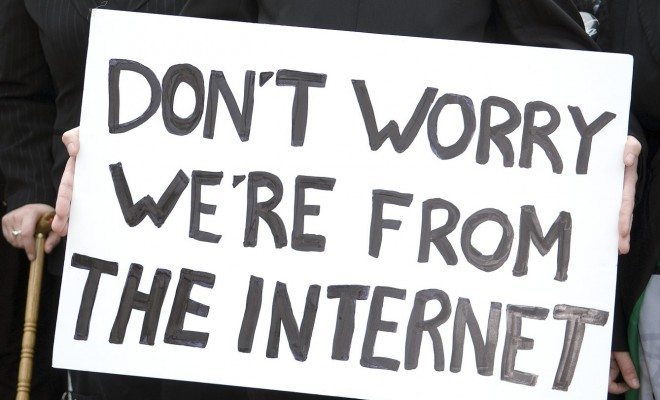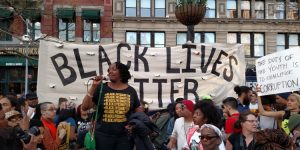
Global protest: The pros and cons of social media
by Bethany Veal
All across the globe, countries experience unrest and conflict between their leaders and the people. This has been evident since civilisation began. However, the form in which this conflict occurs has varied drastically through the ages. Protest in the past often consisted of strong, wealthy figures gathering numerous followers to usurp the current, undesirable power. In contrast, protest now is largely based on social movement groups, without clear, defined leadership and is able to remain inclusive through the use of social media. Social media also enables mass protest nationally and even internationally, in a relatively short time, enabling larger scale and therefore more effective protest. However, social media are also abused by some movements, who use the provided anonymity to organise terrorist attacks and hate groups. This blog will henceforth analyse social media’s presence in protest and determine its pros and cons.
The Arab Spring in Egypt in 2011/2012 was perceived as the first key protest to heavily rely on social media for its success. Zhuo et al state that ‘social media such as Facebook played significant roles in transforming organised groups and informal networks, establishing external linkages, developing a sense of community, and drawing global attention (Zhuo, Wellman, and Yu, 2011: 6). This indicates that, in their view, it were social media that drew the protest together and gave it the mass impact it needed to overthrow the government. This, therefore, can act as a model for other countries who seek democracy and removal of their current leader, for example, Syria. There, social media are often used by anti-Assad rebel groups for numerous reason such as ‘self-promotion, fund-raising, directing attacks, and exchanging tactics’. The use of social media for self-promotion and fund-raising is perhaps the most key to these groups because, as a result, their role has gained international recognition and support from many countries and individuals who also seek Assad’s removal. The donations they give then allow rebel groups to carry out their protest. However, it is important to recognise the risk associated with using social media in these countries. Due to the absence of any human rights protection, were they tracked through their social media and linked to rebel groups or protest attacks, they would likely be killed for their involvement. With this in mind, there must be extreme discretion in countries such as these when using social media, due to the lack of the freedom of speech we enjoy in the West.

© The All-Nite Images | Flickr
The West also heavily rely on social media in protests, maybe even more so as there is more universal access to it. Take for example the women’s marches in America, which were orchestrated through Facebook. This enabled them to be carried out in multiple states at the same time, as they could be organised and advertised through social media. Protestor Jenna Arnold said ‘it would be hard to say that we would have had this kind of success without an existing platform like Facebook’. Tina Davis also suggests a reason for this: ‘It’s about inclusiveness’. This suggests that, in this protest, the openness of social media to all citizens was key to its use.
This also reflects the reason many groups protest across the world for a more democratic form of globalisation, which does not exclude any of society. In this case, Americans were protesting for women’s rights to planned parenthood’s free services, which Donald Trump cut funding for. Due to vast healthcare costs in America, planned parenthood is instrumental in helping those with less money to access healthcare. While separately they would have struggled to make their voices heard, Facebook allowed these individuals to join in the protest, giving their opinions more strength through numbers. Essentially, many see Trump as a divisive president, but social media in this protest broke down divisions and united the people with a common cause.
We have looked at several ways in which social media can be an asset to society when carrying out protests, however, there is also a dark side to this. Social media are also a useful tool for some social movement groups with a violent and hateful nature. As Beck states, ‘[…]terrorist groups are first and foremost movements with political claims and can be analysed as such[…]’ (Beck, 2008: 1566). This definition indicates that terrorism can be seen in the bracket of protest, as terrorist organisations essentially seek change through group action; the key differences being that they protest through violent attacks, and they do not seek democratic government, but instead a new regime. It is well-known Facebook has been utilised by terrorist groups such as ISIS to spread videos of atrocities they commit, in an attempt to rally support and provide inspiration to followers internationally. Media like WhatsApp have been used to organise attacks without the risk of meeting up or being easily traced. Hate groups, such as the KKK also can spread their agenda through social media, as they can organise hate crimes and spread racist propaganda to increase membership.
Chesapeake school children revealed a dark side of children having access to social media, as a handful of them recently circulated images of themselves in KKK uniform after racial divisions in their school got out of hand. In these examples, social media can be seen to have a negative effect on protest as, in the same way, it aids humanitarian protest, it also aids attacks and hate crimes.
Personally, I believe it is impossible to say in definite terms whether wide-spread social media is a positive when it comes to global protest. In general, it is extremely beneficial to peaceful, ordinary members of society, who seek rights, democracy, and welfare, amongst other things. For these people, it is a platform unparalleled in previous years, as it unites those with a common cause internationally. However, it cannot be seen as perfect, due to the ease at which, in the wrong hands, it can be abused.
Offline references
Beck Colin J, The Contribution of Social Movement Theory to Understanding Terrorism, Sociology Compass, vol.2, issue.5, (2008): 1565-1581.
Zhuo X, Wellman B, Yu J, Egypt: The First Internet Revolt?, Peace Magazine, (2011): 6-10.

Superb! Well constructed, balanced view and from such a wide perspective;you have opened my eyes to the full extent of the issues. Thank you.
A good analysis of some of the vital issues that are raised whenever social media is used in an attempt to ‘change’ society. It is fully recognized that social media itself is morally neutral – it all depends on whose hands it is in! Given good motive this blog recognizes the tremendous power for good that exists – with leaders less identifiable, and thereby less exposed to attack. However is not the converse also equally true? Evil leaders also have cloak under which they can hide through social media. These points are validly made by Bethany Veal. However what is needed now is specific study of both types of use – of course those that are constructive, positive, and life-enhancing, but set against those that are destructive, negative and life-denying. Vital issues are raised by this major shift within society.